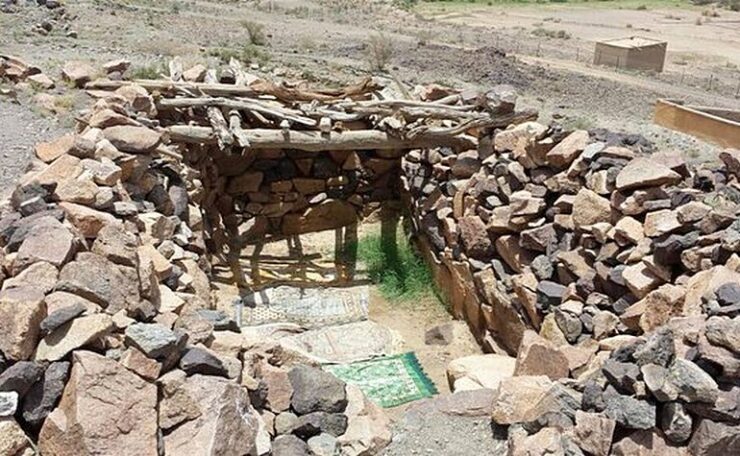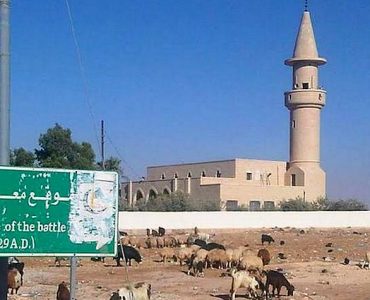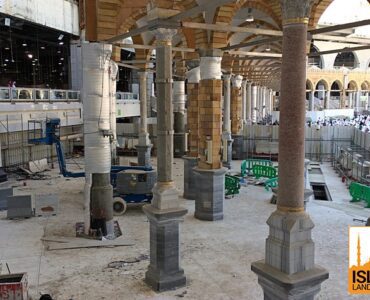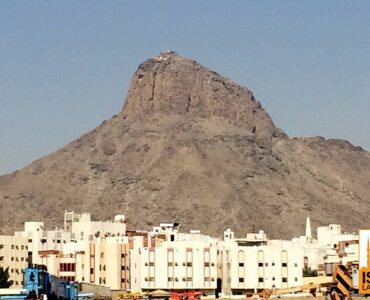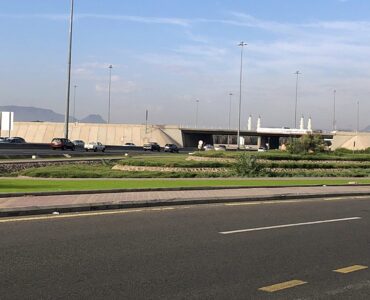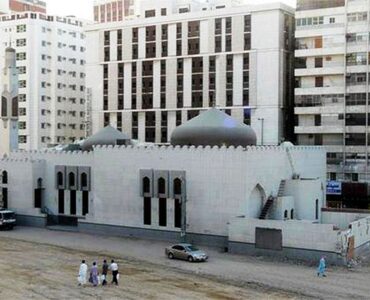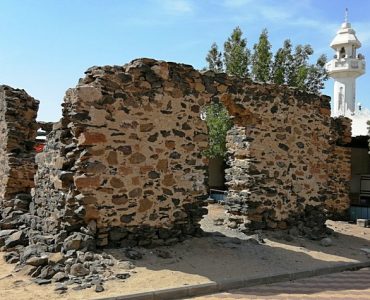These ruins are what remains of the house of Haleemah Sa’diya in the Banu Sa’d region in the desert of Hudaibiyah. Haleemah (رضي الله عنها) fostered the Prophet (ﷺ) here in the early years of his life.
- It was customary among the citizens of Makkah to put their newborns in the care of Bedouin women who would raise them for a couple of years in the desert. The Makkans believed that the unspoiled, rugged desert environment would make their children strong and hardy. Furthermore, an upbringing among the Bedouins ensured that the children would learn the purest form of the Arabic language spoken throughout Arabia.
- Abdul Muttalib was looking for one such Bedouin women who would serve as a wetnurse and take his grandson to the desert. Some women from Banu Sa’d came to Makkah to offer their services to local families. Abdul Muttalib asked each of them to take his grandson Muhammad, but all of them declined the offer when they were told the child’s father was dead. They felt the family of a fatherless child would not be able to reward them handsomely.
- Haleemah bint Abu Dhuwayb had come to Makkah that day. While all the other Bedouin women had found children to nurse, she was not so fortunate. She saw Abdul Muttalib with an infant in his arms and took pity on the child who had been rejected by the other women. She and her husband took the infant Muhammad back to the desert, happy that they were not returning empty-handed. Haleemah and her husband, Harith bin Abdul Uzzah, both belonged to the tribe of Sa’d bin Bakr bin Hawazen. Their children became the Prophet’s foster brothers and sisters. Their names were Abdullah, Anisa, and Judhama, who was better known as Shayma.
- Haleemah and her husband found their lives changed the moment they took Muhammad home. They had travelled to Makkah on a frail female donkey that could barely keep up with their caravan. On the return journey, however, as Haleemah rode with the infant in her arms, the same animal moved so swiftly that it left the caravan behind.
- While Muhammad stayed with Haleemah’s family, the house overflowed with blessings. Haleemah herself narrated that she brought Muhammad to her home during a drought. Her she-camel would not give a drop of milk and her own baby would cry the whole night out of hunger. With the child so distraught, Haleemah and Harith found it hard to sleep at night.
- Things changed, however, when Haleemah brought Muhammad home and placed him on her lap. Her breasts overflowed with milk so that both Muhammad and her own child drank their fill of milk and fell fast asleep. When Harith went to the she-camel, he was amazed at what he saw. The she-camel’s udder were full of milk and ready to overflow. It gave so much milk that Haleemah’s family was able to sleep that night on full stomachs. Haleemah’s household suddenly appeared to be untouched by the drought, although they lived in Dayar Banu Sa’d, the most drought-stricken spot in the region. The family’s goats would return from grazing with their stomachs full of grass and their udders bursting with milk. Husband and wife would milk their goats often while others failed to get even a drop of milk.
- Haleemah’s household continued to be blessed for the next two years, after which she weaned Muhammad. Although he grew up during a great drought, he had developed into a strong, healthy child.
- Every six months Haleemah would take Muhammad to Makkah to be with his mother and other family members. She would then return with him to Dayar Banu Sa’d. After Muhammad was weaned, it was time for him to go back to his family for good. When Haleemah took him back to his mother, she begged Aminah to let her keep the boy longer because he had brought her good fortune. She pleaded he would grow stronger and healthier in the desert, far away from the frequent epidemics that raged in Makkah. Aminah consented, and Haleemah returned home with Muhammad, happy at her extended good fortune.
- Two years later, however, a strange event occurred that frightened Haleemah and her husband, prompting them to return Muhammad to his family in Makkah. Anas bin Malik (رضي الله عنه) relates that one day as Muhammad was playing with some children near Haleemah’s house, Jibreel (عليه السلام) appeared and made Muhammad lie down. He then opened up the boy’s chest, took out his heart, and extracted a lump of flesh from it, saying: ”This is the portion of Satan in you.” Then he put Muhammad’s heart in a golden tray filled with Zamzam water, washed it and replaced it in his chest. The other children ran to Haleemah in terror crying that Muhammad had been killed. When they reached Muhammad, they found him alive, his face pale from shock. Anas (رضي الله عنه) later said that he saw the scar on the Prophet’s (ﷺ) chest where it had been sewn back together.
- In the wake of this supernatural event Muhammad was carried back to Makkah, where for the next two years he grew up under his mother’s care.
- Haleemah (رضي الله عنها) died in 8 AH and is buried in Jannatul Baqi in Madinah.
References: When the Moon Split – Shaikh Safiur-Rahman Mubarakpuri

